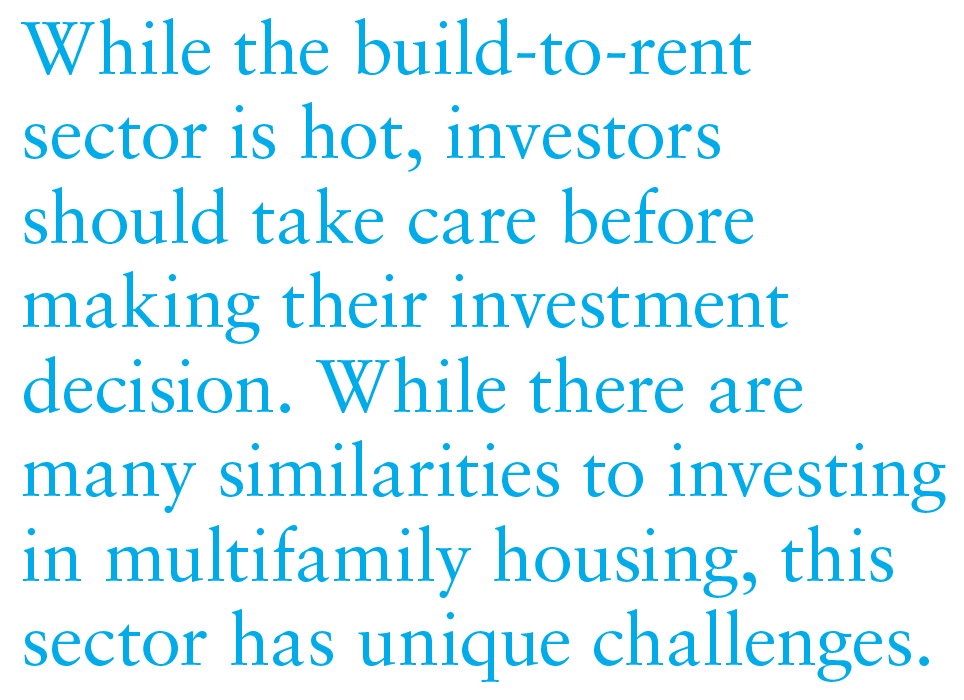The future is bright for build-to-rent housing, and institutional investors are increasingly looking at investing in the sector.
Build-to-rent is hot. Demographics; economic changes; generational shifts in desires, values and priorities; and a pandemic have come together to accelerate growth in what was already one of the fastest growing classes of real estate investment.
Demand for single-family rental homes continues to exceed supply, partly fueled by a surge in demand for rental product from high-income renters (those with an annual household income exceeding US$75,000). Over the past year and a half, this sector has attracted nine- and 10- figure investments from such well-known investors as JP Morgan Asset Management, Blackstone Real Estate Income Trust, Nuveen Real Estate, Walton Street Capital, and CalSTRS, as well as developers such as Brookfield, Lennar, Taylor Morrison, and Toll Brothers, among many others. The Washington Post reported in May 2021 that record occupancy rates are allowing landlords to aggressively increase rents by an astronomical 8% to 10%.[1]
In order to take advantage of this expanding market, developers are building entire communities of rental homes that run on a multifamily management model offering shared open-air amenities, on-site leasing and property management, and predictable and lower maintenance costs. The communities are much more similar to traditional, gated residential neighborhoods with desirable amenities, such as swimming pools, tennis courts, dog parks, and professional management, without burdening residents with the time and expense of home maintenance, homeowner association costs, or a large mortgage. In addition, investors and developers are also scooping up scattered, infill-type lots for building more single-family rental (SFR) product.
BUILD-TO-RENT DRIVERS
During the GFC, institutional investors bought existing, foreclosed single-family homes in bulk at substantial discounts. The investors began to rent them out at attractive yields. Eventually home prices recovered, driving down the rate of return. The maintenance issues that come with older housing, stock, and operational challenges of owning and managing homes across different geographies, pointed these early investors toward a new model—building large communities of single family homes for rent rather than sale.
According to the Harvard Joint Center for Housing Studies’ Rental Housing 2020 report, the number of all SFRs—both previously existing homes and new build-to-rent units—grew 18% from 2008 to 2018 to 15.5 million units, or about a third of all rental units nationally.[2]
There is a large number of “renters-by-choice” millennials, Gen Xers, and downsizing baby boomers who want the space of a single-family home, but without the maintenance obligations of owning or the shared walls, hallways, and limited private outdoor space of most multifamily communities. Millennials with large student loan debt often cannot afford the down payment for a home, or prefer spending disposable income on other things such as vacations. But, as they have aged, they are looking for more space to spread out with their families and pets. According to the National Multifamily Housing Council, tenants who rent single-family homes come from all age groups, with more rental residents living in single-family houses than multifamily units and apartments.[3] Many baby boomers are moving to be close to grandchildren and want the flexibility to follow their children should they move, without the burden of selling and buying a home again
The decision to rent rather than buy is typically not impacted by income or interest rates. More often, it is a result of lack of down payment, undesirable credit score, the strains of student and consumer debt, or more simply, a desire for flexibility. In addition, changes in the tax code (in particular, the limitation on deductibility of state and local taxes) have made homeownership less advantageous.
Add a pandemic to this mix, driving more work from home arrangements and the need for additional space to function as an office. Another reaction to the pandemic has been an atypical number of people moving out of urban areas to less densely populated suburbs where single-family homes are more common.
Together, this makes build- to-rent one of the fastest growing sectors of the US housing market.
While major homebuilders are still primarily focused on building and selling, several major players—namely Lennar, DR Horton, LGI, Taylor Morrison, and Toll Brothers—are moving into the build-to-rent space. There are sound economic reasons for this move. When selling a brand-new home, the builder typically offers the buyer a range of choices of colors, materials, and finishes to personalize one’s home. This step is skipped when building homes for rent, thus reducing time and costs for construction. Eliminating this level of choice allows builders to build the same or similar homes all the way through the subdivision, which creates efficiency and saves money. Overall, returns for a build-to-rent community can often exceed a for-sale project.
THE OPPORTUNITY

Build-to-rent communities are attractive for investors because tenants stay in SFRs longer compared to multifamily or apartment rentals and there are lower transaction costs compared to buying one-off homes listed on the multiple listing service. That said, an SFR among a community of owner-occupied homes may be a more attractive product for renters due to perceptions of greater stability and investment in the neighborhood.
Freddie Mac reports that SFR growth is expected to outpace multifamily, office, retail, storage, and hospitality growth by 2022.[4]
“Occupancy levels are at a thirty-year high,” says Don Walker, Managing Principal and Chief Financial Officer for John Burns Real Estate Consulting, based in San Diego, California.[5] Other developers say that renters of this type of product are “stickier” than typical apartment renters because they see their rental home as more of a long-term decision. Renewal rates are often higher than those for apartments. Rent increases have consistently outpaced those in conventional apartments, and sometimes the margin is quite wide.
Finally, should the investor decide to pull cash out after a few years in the rental business, they can easily refinance or sell off individual properties, which can be a huge advantage over multifamily investing.
WHAT TO LOOK FOR IF INVESTING
Build-to-rent has seen the most rapid growth in the Southwest, Southeast, and Sunbelt markets. Large tracts of land available at more affordable price points, combined with solid economic and population growth, are the most attractive areas for this investment. These regions have seen a significant population influx with the pandemic. How long that trend continues will impact build-to-rent opportunities.
Look for a well-researched market study of the competitive area to support the need for the project. Other data to collect should include population growth trends, job growth and opportunities, and the current rental property inventory for both traditional apartment projects and SFRs. Another consideration is the quality of the school district, as many of the tenants will have school-age children. Lastly, it is important to compare the estimated rental rates for the project and the rental rates of the anticipated competition along with projected net operating income, along with current and projected cap rates in order to evaluate exit strategies.
Investors should watch for challenges in terms of zoning and entitlements. Just as there is often push-back against multifamily, there can often be more pushback against rental homes than those that are built for-sale. This is particularly true in larger communities of rental homes.
The experience of the developer is another key concern. While the design of build-to-rent homes is similar to for-sale homes, experienced build-to-rent developers build the homes with long-term maintenance in mind. Choices such as carpet or tile flooring, and low-maintenance cabinet materials that cost more initially, will save money over time. Developers also may pay more for appliances if they are going to last longer and require less maintenance.
Whether to build a community of SFRs or scatter them over lots in an area will impact your investment as well. While the scattered model may be more attractive for renters and offer an opportunity to invest in markets where large tracts of land may not be available, or there is local resistance to larger build-to-rent communities, this model also loses the economies of scale and ability to provide amenities offered by larger build-to-rent communities.
When looking at exit strategies, it is important to note whether the community is comprised of plotted lots, compared to a horizontal apartment model with multiple units on one lot. The ownership of amenities is also a factor. Individually, plotted lots allow more options for exit, such as selling individual units to the occupant or other investors, or a sale of the entire community. On the other end of the pole, a horizontal apartment model with multiple units on one lot limits your buyer pool to parties with the ability to purchase multiple units. Using a homeowner association model up front for the ownership of amenities (even though it will be solely controlled by the developer initially) also allows flexibility in your exit from the investment.
The future is bright for build-to-rent and savvy institutional investors will focus on developing a deep understanding market fundamentals and trends to find success in this growing sector.

THE HOUSING SECTION
ALSO IN THIS ISSUE (SUMMER 2021)
NOTE FROM THE EDITOR / The Housing Issue
AFIRE | Benjamin van Loon
INVESTOR SENTIMENT / Shining Through Darkness
The 2021 AFIRE International Investor Survey underscores a sense of calculated optimism for CRE investment in the year ahead.
AFIRE | Gunnar Branson
ECONOMY / Revisiting Inflation
For commercial real estate investors, inflation fears are real— but are they rational?
Aegon Asset Management | Martha Peyton, PhD
DEURBANIZATION / Herd Community
Uncertainty surrounding remote work and politics suggest a wide range of potential outcomes for big cities, which may upend the long-running megatrend toward urbanization.
Green Street | Dave Bragg and Jared Giles
HOUSING / How to Rebuild
Could an idea to “bring back” New York after the pandemic work in other cities?
Aria | Joshua Benaim
HOUSING / Single Family, Multiple Questions
Institutional ownership in single-family rentals accounts for less than 5% of the segment, but answers to key questions could change start to change that balance.
Berkshire Residential Investments | Gleb Nechayev, CRE
HOUSING / Institutionalizing Single Family
Over the past two decades, the single-family rental industry has evolved into an institutional-caliber asset class—so where is the sector going next?
Tricon Residential | Jonathan Ellenzweig
HOUSING / Build-to-Rent Boom
The future is bright for build-to-rent and institutional investors are increasingly looking at investing in this sector.
Squire Patton Boggs | John Thomas and Stacy Krumin
OFFICE / Recovering the Office
While most agree that the office sector has a difficult road ahead, there is less consensus about future demand in the sector. What are the indicators investors should be tracking?
Barings Real Estate | Phillip Conner and Ryan Ma
OFFICE / London Calling
With Brexit and pandemic resolutions coming into focus, pricing disparities could dissipate based on improved cross-border liquidity and cap rate compression in the London office market.
Madison International Realty | Christopher Muoio
LOGISTICS / Supply Change
Urbanization, digitalization, and demographics are the key trends to watch for understanding the future of logistics real estate.
Prologis | Melinda McLaughlin and Heather Belfor
CLIMATE / Accounting for Environmental Risk
When it comes to guards against environmental risk, Boston, Indianapolis, Minneapolis, and Portland are some of the most prepared US cities. What makes them different?
Yardi Matrix | Paul Fiorilla, Claire Anhalt, and Maddie Harper
ESG / Putting People First
Though “impact investing” is no longer totally distinct from investing in general, investors still have a lot of work to do for fulfilling the social and governance aspects of ESG expectations.
Grosvenor Americas | Lauren Krause and Brian Biggs
MULTIFAMILY / Influencing Multifamily
As we come out of the pandemic to a new economy, it seems likely that the creator economy will continue to grow. This will have a major impact on the multifamily sector.
citizenM Hotels | Ernest Lee
TALENT / Enhancing Life Sciences
As the global life sciences sector continues to grow in real estate, highly specialized skills and experience will be the keys to success.
Sheffield Haworth | Max Shepherd and Jannah Babasa
EDUCATION / Real Estate Education Goes Global
The evolution of global real estate education over the past three decades will be integral to developing a rich pipeline of talent for the future of commercial real estate.
Georgetown University | Julian Josephs, FRICS
—
ABOUT THE AUTHORS
Stacy Krumin is a Real Estate Practice Partner and John Thomas is a Real Estate Practice Leader and Partner at Squire Patton Boggs, a full-service global law firm providing insight at the point where law, business, and government meet.
—
NOTES
1. “Single-family home landlords hike rents amid strong demand for suburban houses.” Washington Post. May 7, 2021. https://www.washingtonpost.com/business/economy/single-family-home-landlords-hike-rents-amid-strong-demand-for-suburban-houses/2021/05/07/a6741960-aeac-11eb-ab4c-986555a1c511_story.html
2. “America’s Rental Housing 2020.” Joint Center for Housing Studies of Harvard University. Accessed June 22, 2021. https://www.jchs.harvard.edu/americas-rental-housing-2020
3. “Household Characteristics.” National Multifamily Housing Council. Accessed June 22, 2021. https://www.nmhc.org/research-insight/quick-facts-figures/quick-facts-resident-demographics/household-characteristics/
4. “Spotlight On Underserved Markets.” Freddie Mac Multifamily. Accessed June 22, 2021. https://mf.freddiemac.com/docs/single-family-rental-markets.pdf
5. “Investors are Making a Big Bet on Build-to-Rent Single Family Homes.” 2020. SFRHub Advisors. December 15, 2020. https://sfrhubblog.com/2020/12/15/investors-are-making-a-big-bet-on-build-to-rent-single-family-homes/






